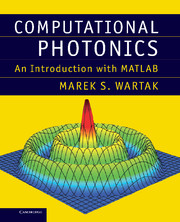Book contents
- Frontmatter
- Contents
- Preface
- 1 Introduction
- 2 Basic facts about optics
- 3 Basic facts from electromagnetism
- 4 Slab waveguides
- 5 Linear optical fibre and signal degradation
- 6 Propagation of linear pulses
- 7 Optical sources
- 8 Optical amplifiers and EDFA
- 9 Semiconductor optical amplifiers (SOA)
- 10 Optical receivers
- 11 Finite difference time domain (FDTD) formulation
- 12 Beam propagation method (BPM)
- 13 Some wavelength division multiplexing (WDM) devices
- 14 Optical link
- 15 Optical solitons
- 16 Solar cells
- 17 Metamaterials
- Appendix A Basic MATLAB
- Appendix B Summary of basic numerical methods
- Index
Preface
Published online by Cambridge University Press: 05 July 2013
- Frontmatter
- Contents
- Preface
- 1 Introduction
- 2 Basic facts about optics
- 3 Basic facts from electromagnetism
- 4 Slab waveguides
- 5 Linear optical fibre and signal degradation
- 6 Propagation of linear pulses
- 7 Optical sources
- 8 Optical amplifiers and EDFA
- 9 Semiconductor optical amplifiers (SOA)
- 10 Optical receivers
- 11 Finite difference time domain (FDTD) formulation
- 12 Beam propagation method (BPM)
- 13 Some wavelength division multiplexing (WDM) devices
- 14 Optical link
- 15 Optical solitons
- 16 Solar cells
- 17 Metamaterials
- Appendix A Basic MATLAB
- Appendix B Summary of basic numerical methods
- Index
Summary
Photonics (also known as optoelectronics) is the technology of creation, transmission, detection, control and applications of light. It has many applications in various areas of science and engineering fields. Fibre optic communication is an important part of photonics. It uses light particles (photons) to carry information over optical fibre.
In the last 20 years we have witnessed the significant (and increasing) presence of photonics in our everyday life. The creation of the Internet and World Wide Web was possible due to tremendous technical progress created by photonics, development of photonic devices, improvement of optical fibre, wavelength division multiplexing (WDM) techniques, etc. The phenomenal growth of the Internet owes a lot to the field of photonics and photonic devices in particular.
This book serves as an attempt to introduce graduate students and senior undergraduates to the issues of computational photonics. The main motivation for developing an approach described in the present book was to establish the foundations needed to understand principles and devices behind photonics.
In this book we advocate a simulation-type approach to teach fundamentals of photonics. We provide a self-contained development which includes theoretical foundations and also the MATLAB code aimed at detailed simulations of real-life devices.
We emphasize the following characteristics of our very practical book:
• learning through computer simulations
• writing and analysing computer code always gives good sense of the values of all parameters
• our aim was to provide complete theoretical background with only basic knowledge assumed
• the book is self-contained in a sense that it starts from a very basic knowledge and ends with the discussion of several hot topics.
- Type
- Chapter
- Information
- Computational PhotonicsAn Introduction with MATLAB, pp. xi - xivPublisher: Cambridge University PressPrint publication year: 2013



